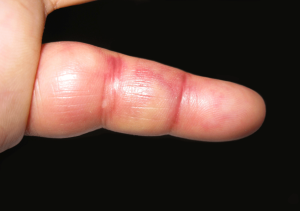Rugger-Jersey Finger
What is it?
Rugger Jersey finger is an injury to the deep (flexor) tendon at the tip of the finger. The deep flexor tendon (known as the FDP) runs along the palm surface of the finger and its job is to bring your finger tip into your palm when you make a fist. Tendons are structures, which attach muscles to bone enabling us to move our joints.
Who gets it and what causes it?
This injury classically occurs in rugby or American football when one player grabs another player’s shirt or jersey with just the fingertips. The forces involved as the other player pulls away cause the injury.

What are the signs and symptoms?
Patients may experience pain, swelling and bruising at the fingertip. The affected finger is usually the ring finger and will appear unusually straight due to the injury to the tendon. There will be difficulty in the patient trying to bend the finger.
What tests will I need?
The first step is to undergo a consultation, involving a medical history and clinical examination. Mr Naqui may organise further tests such as an x-ray, ultrasound scan or MRI scan. An x-ray can reveal if there has been an associated fracture of the bone. Ultrasound and MRI scan can help identify the extent of the injury to the tendon.
What is the treatment?
Treatment depends on the extent of the injury and how long ago it occurred. If it has not been too long, the tendon could be repaired and re-attached. If the injury has been some time ago, it maybe that a new tendon will need to be inserted or the fingertip fused. Mr. Naqui will discuss the options with you.
What does the surgical treatment involve?
Surgery is performed under regional or general anaesthetic. The tendon will be identified and brought back to where it detached from. A splint will be applied to protect the repair. You will be able to go home the same morning or afternoon.
What happens after the surgery?
Taking simple painkillers such as paracetamol regularly for the first 2 days after the operation will help to relieve any post-operative pain.
Mr. Naqui and the hand therapist will then provide you with a specially adapted splint and specific exercises to perform to maintain normal movements in the hand.
Skin stitches are usually removed after 10 days. Depending on whether the tendon has been repaired or replaced there is a carefully co-ordinated hand therapy programme tailored for your finger.
When I can return to normal activity?
Tendon healing takes around 6 weeks. Strengthening exercises will be tailored to your individual repair. It is usually 3 months before you can use the fingertip for highly strenuous activity.
Mr. Naqui will discuss with you regarding return to sports depending upon your particular sport – as a protective splint could be worn to help you get back to sport earlier. Driving can safely be resumed at around 4 weeks, depending on your splint. Return to work is dependent on the nature of you work but usually expected within 2 weeks if it is non-manual work. You can discuss this with Mr Naqui at your consultation.
What are the complications of surgery?
The main potential complications that will be discussed with your prior to gaining consent for surgery include pain, swelling, infection, stiffness, scarring, numbness, weakness of grip and re-rupture.
Pain and swelling are common following surgery, these should settle after a few days with simple painkillers. Infection is rare. Stiffness at the joint should resolve if you follow the exercise programme as advised by Mr Naqui and the hand therapist following surgery.
In a small proportion of patients there is ongoing weakness or a re-tear of the tendon. If this were to happen then there are further non-surgical and surgical options, which you can discuss with Mr Naqui.





